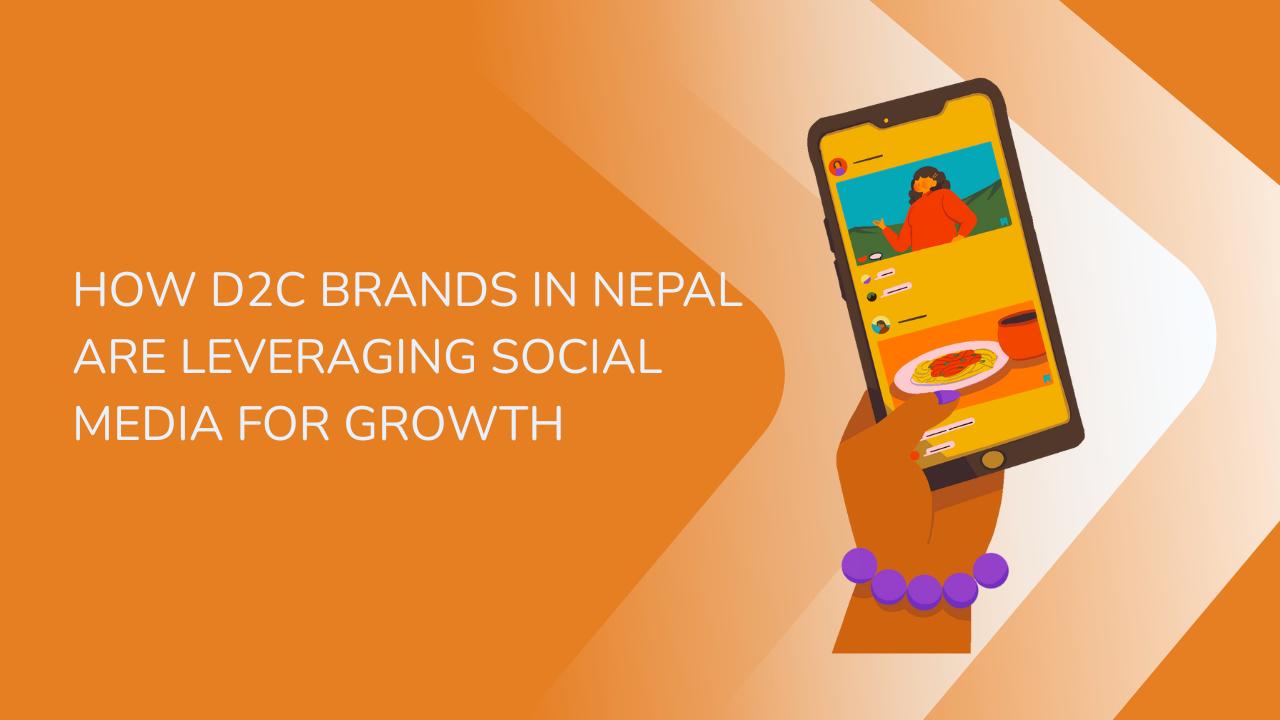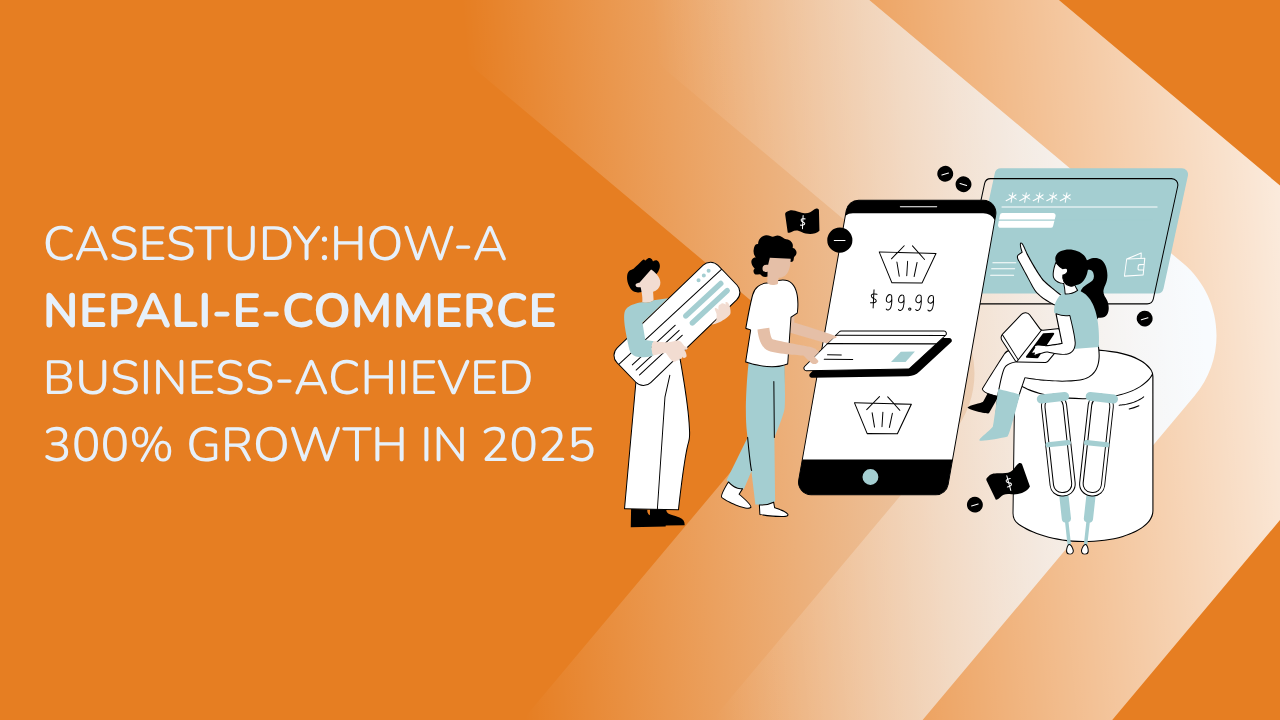Share this Article
Over the past decade, Nepal has seen a rapid digital transformation. With increasing mobile and internet penetration, the country's e-commerce sector has also been experiencing significant growth. This digital shift has created new opportunities for businesses, particularly Direct-to-Consumer (D2C) brands. These brands are capitalizing on the expanding digital landscape to reach consumers directly, offering a more personalized and streamlined shopping experience. In this blog, we will explore how the rise of mobile and internet usage in Nepal is benefiting D2C brands and how they are leveraging this shift to expand their presence and grow in the Nepali market.
1. The Rise of Mobile and Internet Usage in Nepal
Nepal’s mobile and internet usage has grown exponentially in recent years. With an increase in the number of smartphone users and the expansion of 4G networks across the country, internet access has become more widespread and affordable. According to recent reports, mobile penetration in Nepal exceeds 150%, with a large portion of the population relying on mobile phones for internet access. As a result, more people in both urban and rural areas are using mobile phones to shop online, engage with brands, and consume content. This has created an ideal environment for D2C brands to reach consumers in ways that were previously impossible.
Impact on D2C Brands:
- Wider Reach and Accessibility:
The rapid growth in mobile internet usage in Nepal allows D2C brands to target consumers not only in urban centers but also in remote rural areas. Traditionally, consumers in rural parts of the country faced challenges in accessing products and services, as the lack of physical stores and logistical infrastructure limited their options. With the rise of mobile usage and the growing accessibility to the internet, D2C brands can now reach these consumers and cater to their needs by offering products directly to their doorsteps through e-commerce platforms. This wide accessibility has helped D2C brands expand their customer base beyond traditional retail channels.
- Mobile Optimization for Seamless Shopping Experiences:
As mobile internet usage continues to rise, D2C brands in Nepal are optimizing their websites and mobile applications to provide smooth and intuitive shopping experiences on smartphones. By designing responsive websites and easy-to-use mobile apps, brands ensure that customers can easily browse products, make purchases, and track their orders. The shift to mobile-optimized platforms has made it easier for customers to shop on the go, leading to increased customer satisfaction and repeat purchases. With mobile shopping becoming increasingly popular in Nepal, D2C brands are ensuring that their websites and apps are designed to meet the needs of mobile-first shoppers.
2. The Expansion of Online Payment Systems
In Nepal, online payment systems were once a major barrier to the growth of e-commerce. Many consumers were hesitant to make online payments due to concerns about security and trust. However, the rise of mobile wallets and online payment platforms has significantly improved the payment landscape. Platforms like eSewa, Khalti, IME Pay, and Fonepay have gained widespread popularity, offering safe and convenient digital payment options. As more consumers use digital wallets, the barrier to online payments has diminished, making it easier for D2C brands to process transactions securely and efficiently.
Impact on D2C Brands:
- More Payment Choices for Consumers:
The availability of multiple online payment options allows D2C brands to cater to the diverse payment preferences of Nepali consumers. While some customers prefer to pay through mobile wallets, others might prefer bank transfers or credit/debit card payments. D2C brands can offer a variety of payment methods, ensuring that every customer can find an option they are comfortable with. This flexibility not only increases sales but also makes the shopping experience more convenient for consumers.
- Increased Consumer Confidence in Online Payments:
As more Nepali consumers become familiar with digital payment systems, they are more likely to trust online transactions. D2C brands that integrate reliable and secure payment gateways can boost consumer confidence in their platforms. Transparent payment processes, such as showing clear breakdowns of the total cost, will also reassure customers that they are not being overcharged or subjected to hidden fees. By providing safe payment options and educating consumers about secure payment methods, D2C brands can establish trust and encourage more people to shop online.
- Enabling International Transactions:
In addition to facilitating domestic payments, online payment systems also make it easier for Nepali consumers to make international purchases. For D2C brands that sell imported products or want to expand into international markets, this is a huge advantage. By offering international payment options and ensuring a smooth payment process, D2C brands can tap into the growing demand for cross-border products in Nepal and build their customer base both locally and globally.
3. Social Media: A Powerful Marketing Tool
In Nepal, social media platforms such as Facebook, Instagram, and TikTok have become integral parts of people’s daily lives. As mobile internet usage increases, social media platforms are emerging as powerful tools for discovering products, engaging with brands, and making purchasing decisions. For D2C brands, social media offers a direct and cost-effective way to reach a large audience, build brand awareness, and drive sales. These platforms allow brands to engage with consumers in a more personal and relatable way, which is essential for establishing trust and loyalty.
Impact on D2C Brands:
- Building Direct Relationships with Customers:
Social media enables D2C brands to connect with their customers directly, bypassing traditional intermediaries. Through platforms like Facebook and Instagram, brands can communicate with consumers, answer their questions, and provide personalized support. By engaging with customers on social media, brands create a sense of community and foster a more personal relationship with their audience. This direct engagement helps build trust, as consumers feel more connected to the brand and are more likely to return for repeat purchases.
- Influencer Collaborations and Social Proof:
Influencer marketing has gained significant traction in Nepal, especially among younger, tech-savvy consumers. Nepali influencers with large followings on Instagram, YouTube, and TikTok can help D2C brands gain credibility and reach a wider audience. Consumers tend to trust influencers because they see them as authentic, and their endorsements can have a direct impact on purchasing decisions. By collaborating with local influencers who align with their values, D2C brands can effectively promote their products and increase brand awareness. Influencers create social proof that helps potential customers trust the brand, knowing that it is endorsed by someone they follow and admire.
- Targeted Advertising for Higher Engagement:
Social media platforms offer advanced targeting features that allow D2C brands to tailor their advertisements to specific demographics. Whether it’s based on age, location, interests, or behavior, targeted advertising helps brands reach the right audience at the right time. This ensures that advertising dollars are spent efficiently, driving higher engagement rates and boosting conversion. For D2C brands operating in Nepal, where consumers are often bombarded with advertisements, targeted ads ensure that their message reaches only those who are most likely to convert into customers.
4. E-Commerce Marketplaces: An Alternative for D2C Brands
While many D2C brands prefer to operate their own e-commerce platforms, e-commerce marketplaces like Daraz and SastoDeal have become increasingly popular in Nepal. These platforms allow brands to showcase their products to a larger audience without having to invest heavily in developing their own website. Marketplaces offer the added advantage of a trusted and established platform where consumers feel confident making purchases. These platforms also handle many of the logistical challenges associated with running an e-commerce business, such as payment processing and customer support, which can be particularly beneficial for new or small D2C brands.
Impact on D2C Brands:
- Increased Visibility and Wider Reach:
By listing products on popular e-commerce platforms, D2C brands can benefit from the platform’s established customer base. This increases the visibility of their products and provides access to a larger audience that may not have discovered the brand otherwise. Marketplaces offer a ready-made audience of shoppers, which helps D2C brands build their presence without needing to drive traffic to their own website. For D2C brands that are new to the market, this is an effective way to gain recognition and grow their customer base quickly.
- Leverage Marketplace Features for Growth:
Many e-commerce marketplaces offer features like promotions, discounts, and featured listings that can help D2C brands increase their sales. By participating in platform-wide sales events or special promotions, D2C brands can take advantage of the marketplace’s marketing efforts to boost their product’s visibility. Additionally, the reputation of well-established platforms like Daraz can also instill confidence in potential customers, which may lead to higher conversion rates.
- Cost-Effective Marketing:
Marketplaces often handle much of the marketing for D2C brands by promoting their platform as a whole, running ads, and offering discounts to attract customers. This reduces the need for brands to invest large sums in standalone marketing campaigns. For smaller D2C brands, this is particularly beneficial, as they can benefit from the marketplace’s existing infrastructure to drive traffic and generate sales without significant upfront costs.
5. The Role of Data Analytics in Personalization
As internet and mobile usage increase, D2C brands in Nepal are gathering more consumer data than ever before. By analyzing browsing habits, purchase history, and customer preferences, brands can gain valuable insights into consumer behavior. This data allows D2C brands to offer personalized shopping experiences that cater to the unique needs of individual customers. Personalization plays a critical role in driving customer loyalty and increasing sales.
Impact on D2C Brands:
- Tailored Shopping Experience:
Data analytics enables D2C brands to personalize the shopping experience for their customers. By offering personalized product recommendations based on past purchases or browsing behavior, brands can make the shopping experience more relevant and engaging for customers. This not only helps increase conversion rates but also fosters a stronger connection between the brand and its customers.
- Targeted Promotions and Discounts:
D2C brands can use data to send personalized promotions and discounts to customers based on their shopping history. For example, if a customer frequently buys a particular product or brand, the brand can send targeted offers related to those products. By offering relevant discounts and promotions, D2C brands can encourage repeat purchases and increase customer loyalty.
- Improved Inventory Management:
Through data analysis, D2C brands can forecast demand and optimize their inventory levels. By understanding which products are most popular, brands can ensure that they always have stock available for their best-selling items. This helps brands avoid stockouts or excess inventory, improving operational efficiency and customer satisfaction.
Conclusion: D2C Brands and the Digital Future of Nepal
The rise of mobile and internet usage in Nepal has created a host of new opportunities for D2C brands to thrive in the market. As mobile devices become the primary means of internet access, and as digital payment systems gain popularity, D2C brands are able to engage with consumers in innovative ways. Social media platforms, e-commerce marketplaces, and data analytics are also helping brands personalize the shopping experience, drive sales, and expand their reach.
In the coming years, as internet penetration continues to grow and mobile usage becomes even more widespread, D2C brands will have even greater opportunities to capitalize on Nepal’s digital shift. By embracing these trends, D2C brands can strengthen their relationships with consumers, improve their offerings, and position themselves for long-term success in the Nepali market.
Categories:
E-commerce Tips & Tutorials
Tags:
local businesses
,
e-commerce app
,
E-commerce
,
Global E-commerce
,
Nepali businesses
,
e-commerce landscape.







